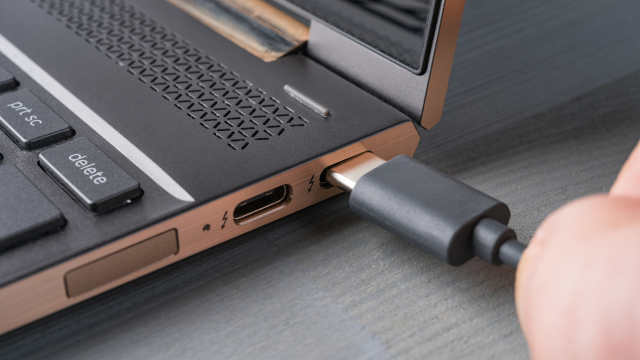Come 2026, laptops sold within the European Union will be required to use USB-C as the charging port, for the same reason that phones are required to have the same port – standardisation. But, did you know that you can use a non-standard USB-C cable as a charger for some laptops today?
Now, firstly, let’s just cover how most laptops today do use USB-C as the standard charging cable. Laptops from Lenovo, ASUS, Framework and Huawei, for example, each use powerful USB-C chargers instead of proprietary ports made specifically for charging (though some models don’t use USB-C).
However, manufacturers like Microsoft (for its Surface range) and Dell (for some specific models), along with some older-model laptops (and more powerful computers, such as gaming laptops), use specific connectors for charging up. Microsoft probably is the most egregious example of this, with its surface connector being quite bulky and taking up a lot of real estate on the side of your computer.
That being said, in some cases, you don’t need to use this port – nor the specific non-USB-C charging port that your laptop is likely reliant on.
Can I use USB-C as a laptop charger?
For laptops where this is the standard mode of charging, absolutely. For laptops where it’s not, you should definitely check online before plugging a USB-C charger into a USB-C port – but broadly speaking, it’s possible to do this.
For this, we recommend Googling your specific laptop model. You can find your specific model by checking the model number on the back of the laptop, or by looking in your PC settings (press the Windows key, type ‘about’ and click ‘about this PC’).
Information on whether or not your PC may support USB-C charging may come in the form of a blog post, tech support post or an article directly addressing the issue. Here’s what that looks like from several major laptop manufacturers (though to reiterate, your specific laptop model may have a different configuration to what is discussed in the below articles):
If you can’t find any information on your specific laptop regarding USB-C charging capability, it’s worth either checking the manual or contacting the manufacturer (either in the form of a community post or technical support).
There are several things worth noting, however, about charging your laptop with a USB-C port instead of the standard non-USB-C charger. Firstly, charging speed might be limited or slower, compared to when using the dedicated charging cable. This is the case with Microsoft Surface and Dell laptops.
In this case, it’s worth using a USB-C charger only in the event of an emergency or when the standard charger isn’t available. Personally, I use a Microsoft Surface laptop as my work computer, and when I don’t have the proprietary Surface charger nearby (which is very rarely), I use a Framework or MacBook Pro laptop USB-C charger.
Additionally, as pointed out by PCMag, using the standard AC charger that your device came with in the first place is always recommended over a USB-C charger, especially if the USB-C charger is of poor quality, as pointed out by ZDNet. If you’re going to use a USB-C charger, it’s worth getting a good quality one from an established brand, or even the laptop manufacturer itself.
Furthermore, as pointed out by PC World, your USB-C charger might be unable to provide adequate power in some circumstances, such as with gaming laptops. In these cases, where a bulky, high-power laptop charger is provided as standard, it’s definitely recommended that you use these, especially if you’re going to be working the computer hard with graphics-intensive applications.
And finally, not all USB-C ports support power delivery. This is likely the biggest thing holding you up if you’re trying to charge a laptop with USB-C. If charging is not available via the USB-C port you’re using, try switching to a separate port.
Just food for thought, in case you’re missing your standard laptop charger.
